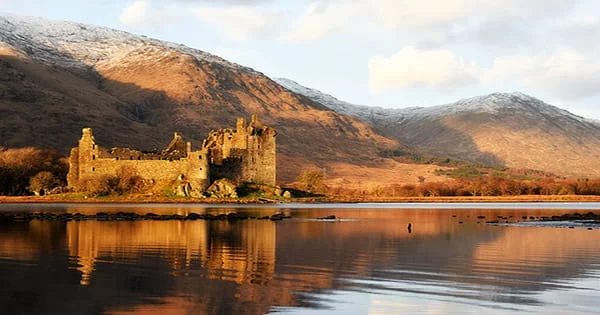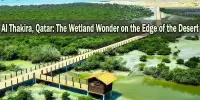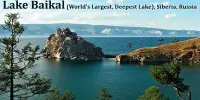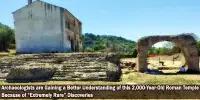Kilchurn Castle is a destroyed 15th-century castle in Argyll and Bute, Scotland, that was erected around 1450 on the northeastern extremity of Loch Awe. It was built in the mid-15th century as a base for the Campbells of Glenorchy, who over the next 150 years expanded both the castle and their land in the region. The tower house and Laich Hall were the first structures built on the castle grounds. It is now one of Scotland’s most photographed structures due to its scenic surroundings and romantic state of deterioration.
Kilchurn went out of use once the Campbells became Earls of Breadalbane and relocated to Taymouth Castle, and by 1770 it was in ruins. Historic Environment Scotland presently looks after it, and it is available to the public during the summer. The Campbells were able to control access from the east to the territories of Lorn thanks to the castle’s location at the end of the Brander Pass, which connected their domains in Lorn with their estates in Perthshire. The castle was erected on an island that was connected to the mainland by a concealed causeway beneath the water’s surface.
Kilchurn Castle is situated against the background of Tyndrum’s mountains. When the loch’s waters are high, Kilchurn is cut off from the rest of the world, stranded on a marshy island barely broader than the castle. It was abandoned in the 1700s, but because of its (clearly) spectacular setting, it is today one of the most photographed castles. The Campbells of Glenorchy were the most powerful cadet branch of the Clan Campbell, and they dominated the central Highlands for two centuries beginning in the 1430s.

During this time, the construction of various castles, the first of which was Kilchurn, was an important component of their territorial expansion. Additional defenses and structures were built throughout the next two centuries. According to current maps of the region, the water level kept it permanently blocked off from the mainland, and the only way to get there was presumably by a tunnel beneath the loch.
The water level has dropped over time, and the entrance to Kilchurn is now completely above water, so there’s no need to guess where the aquatic causeway is located. The initial castle consisted of a five-story tower house surrounded by an exterior wall and a courtyard. Kilchurn was on a small island at the time, barely bigger than the castle, and would have been reached via an underwater or low-lying bridge.
The shifting political atmosphere of early modern British politics affected Castle Kilchurn. Throughout the English Restoration, Sir John Campbell strengthened it, and it served as a government garrison during the Jacobite rebellions of the early 18th century. Until roughly 1760, the Glenorchy-Campbell family owned the castle. Margaret Campbell, Sir Colin’s wife, is said to have handled the Kilchurn construction project during her husband’s long absence fighting abroad.
Another Sir Colin Campbell, the 6th Laird (1499–1583), renovated the castle’s accommodation in the second part of the 16th century by building additional chambers to the north of the tower house and refurbishing the parapet. At least at first, the Campbells did not dwell at Kilchurn. The MacGregors of Glenstrae were appointed as keepers. This agreement continued until the clans split out in the 17th century, resulting in a deadly conflict.
After being severely devastated by a terrible lightning strike, the castle was abandoned. It remained virtually untouched over the next few decades as it deteriorated owing to decades of neglect. In 1614, Sir Duncan had the castle’s south range repaired and extended, as well as a new range with a chapel in the courtyard’s southeast corner. Black Duncan also started work on Finlarig Castle near the west end of Loch Tay, as well as improving farms around the castles of Finlarig, Kilchurn, and Balloch. Kilchurn Castle, like Innischonnel Castle on the south coast of Loch Awe, was a Clan Campbell stronghold.
More bloodshed occurred in 1654 when a Royalist force led by General Middleton besieged Kilchurn for two days before being forced out by Cromwellian forces dispatched by General Monck. However, the reprieve was short-lived, as the Earl of Argyll revolted against James VII in 1685 and dispatched his forces to besiege Kilchurn once more. He pushed a plan to subdue the Highlands in the 1690s, and as part of it, he began converting Kilchurn into a modern barracks capable of accommodating 200 men. The three-story L-shaped block on the north side was his most notable addition.
Apart from a Clan feud with the MacGregors, Kilchurn Castle does not appear to have seen much combat. It became a garrison for Hanoverian (Redcoat) Troops after the Jacobite Rebellion. They would have been the final tenants, as the castle was abandoned in the 1760s when a lightning strike sparked a fire. By 1770, the castle had lost its roof. During one of his early 19th-century trips of Scotland, J M W Turner painted the castle.
The water level of Loch Awe was raised in 1817, causing the castle to be built on a lengthy peninsula. In approximately 1887, MacGibbon and Ross conducted a study of the castle, following which restoration work appears to have changed some of the castle’s original characteristics. Kilchurn is now exposed to the elements. Visitors may climb the original five-story tower and other parapets thanks to many wooden steps and walkways constructed into the structure.
The tower provides breathtaking views over the hills to the north as well as the abandoned viaduct in the distance. A panoramic display looking back down the lake shows the medieval Dukes of Argyll’s ultimate resting place, as well as the modest churches constructed on the loch’s various islands. On the first floor, there is a vaulted storage cellar and a jail, and on the lowest level, there is a vaulted storage cellar and a prison.
Upper-floor stairwells are built into the angles of the walls. The round-angle towers on the north and south walls of the 17th-century barracks are another eye-catching features. Historic Environment Scotland presently owns the ruin, which is available to the public during the summer. The only way to get there is to take a boat from Lochawe pier or walk from the A85 near Dalmally. The entrance is hidden beneath the railway viaduct that spans Loch Awe, and access is occasionally hampered by higher-than-normal water levels in the loch, which transform the place into a temporary island.
















